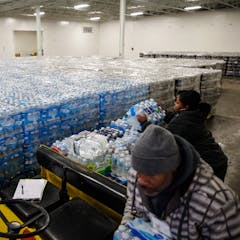
Articles on Louisiana
Displaying 1 - 20 of 27 articles

Extreme downpours and droughts, both fueled by rising global temperatures, are taking a toll on water infrastructure. Communities trying to manage the threats face three big challenges.

Carbon capture is turning the oil and gas industry into a critical player for mitigating climate change – while its products continue to heat up the planet.

Louisiana’s governor made it easier for companies to receive property tax breaks – and schools will likely pay the price.

An estimated 95% of US cities provide economic development tax incentives to woo corporate investors, taking billions away from schools.

An estimated 95% of US cities provide economic development tax incentives to woo corporate investors, taking billions away from schools.

Does Louisiana’s requirement for public schools to post ‘In God We Trust’ in all classrooms violate the doctrine of separation of church and state? A legal scholar weighs in.

Dependence on bottled water weakens pressure to fix tap-water problems. Who pays the price?

By making individuals responsible for reducing pollution and greenhouse gas emissions, the oil industry is deflecting responsibility for making profound changes in their production practices.

The US is a latecomer to offshore wind development, but President Biden has set big goals for expanding it. The Gulf of Mexico has good conditions and a large offshore energy industry.

Sugar has deep links with slavery in the US, but Black workers weren’t the only ones affected. In post-Civil War Louisiana, Chinese workers also toiled cutting and processing cane.

Before the Civil War, US activists sought to combat slavery through sugar boycotts. Instead, consumption grew.

As the state copes with hurricanes and climate disasters, it is figuring out how to manage the slow-motion loss of its coastal land. But its plans could endanger the cultures that define the region.

Hurricane Ida left the entire city of New Orleans in the dark and renewed discussion of burying power lines. But there’s no way to completely protect the grid, above ground or below.

Sixteen years after Hurricane Katrina made landfall, the Category 4 storm Hurricane Ida reached Louisiana. Planning for future hurricanes must include the need to build resiliency to climate change.

The New Orleans region is likely to see a hurricane about every seven years and a major hurricane about every 20.

New Orleans has about a 40% chance of getting hit by a tropical storm in any given year. Here’s how heat, winds and the shape of the seafloor raise the hurricane damage risk.

Is the public education that Ruby Bridges fought to integrate a relic of the past?

Police experience in crisis and hostage negotiation could come in handy when dealing with cybercriminals who have, effectively, kidnapped data.

A reenactment of the largest slave rebellion in US history involves a plot twist. A scholar who studies race, history and memory says the new ending can spark new beginnings.

The gap between rich and poor is at record levels in the U.S., yet it varies widely among the states. A political scientist explains why.





